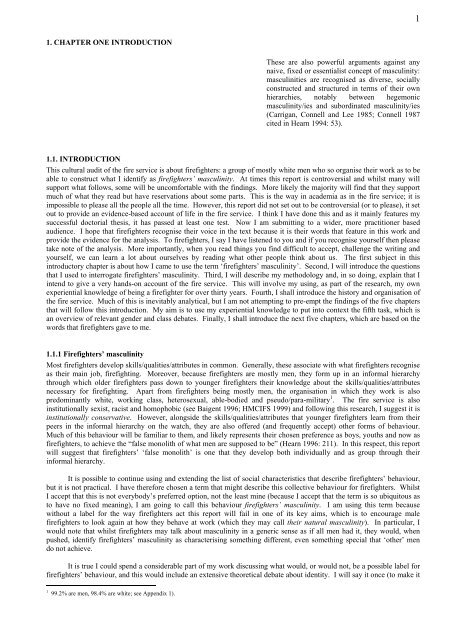One more last working class hero
One more last working class hero
One more last working class hero
Create successful ePaper yourself
Turn your PDF publications into a flip-book with our unique Google optimized e-Paper software.
1<br />
1. CHAPTER ONE INTRODUCTION<br />
These are also powerful arguments against any<br />
naive, fixed or essentialist concept of masculinity:<br />
masculinities are recognised as diverse, socially<br />
constructed and structured in terms of their own<br />
hierarchies, notably between hegemonic<br />
masculinity/ies and subordinated masculinity/ies<br />
(Carrigan, Connell and Lee 1985; Connell 1987<br />
cited in Hearn 1994: 53).<br />
1.1. INTRODUCTION<br />
This cultural audit of the fire service is about firefighters: a group of mostly white men who so organise their work as to be<br />
able to construct what I identify as firefighters’ masculinity. At times this report is controversial and whilst many will<br />
support what follows, some will be uncomfortable with the findings. More likely the majority will find that they support<br />
much of what they read but have reservations about some parts. This is the way in academia as in the fire service; it is<br />
impossible to please all the people all the time. However, this report did not set out to be controversial (or to please), it set<br />
out to provide an evidence-based account of life in the fire service. I think I have done this and as it mainly features my<br />
successful doctorial thesis, it has passed at least one test. Now I am submitting to a wider, <strong>more</strong> practitioner based<br />
audience. I hope that firefighters recognise their voice in the text because it is their words that feature in this work and<br />
provide the evidence for the analysis. To firefighters, I say I have listened to you and if you recognise yourself then please<br />
take note of the analysis. More importantly, when you read things you find difficult to accept, challenge the writing and<br />
yourself, we can learn a lot about ourselves by reading what other people think about us. The first subject in this<br />
introductory chapter is about how I came to use the term ‘firefighters’ masculinity’. Second, I will introduce the questions<br />
that I used to interrogate firefighters’ masculinity. Third, I will describe my methodology and, in so doing, explain that I<br />
intend to give a very hands-on account of the fire service. This will involve my using, as part of the research, my own<br />
experiential knowledge of being a firefighter for over thirty years. Fourth, I shall introduce the history and organisation of<br />
the fire service. Much of this is inevitably analytical, but I am not attempting to pre-empt the findings of the five chapters<br />
that will follow this introduction. My aim is to use my experiential knowledge to put into context the fifth task, which is<br />
an overview of relevant gender and <strong>class</strong> debates. Finally, I shall introduce the next five chapters, which are based on the<br />
words that firefighters gave to me.<br />
1.1.1 Firefighters’ masculinity<br />
Most firefighters develop skills/qualities/attributes in common. Generally, these associate with what firefighters recognise<br />
as their main job, firefighting. Moreover, because firefighters are mostly men, they form up in an informal hierarchy<br />
through which older firefighters pass down to younger firefighters their knowledge about the skills/qualities/attributes<br />
necessary for firefighting. Apart from firefighters being mostly men, the organisation in which they work is also<br />
predominantly white, <strong>working</strong> <strong>class</strong>, heterosexual, able-bodied and pseudo/para-military 1 . The fire service is also<br />
institutionally sexist, racist and homophobic (see Baigent 1996; HMCIFS 1999) and following this research, I suggest it is<br />
institutionally conservative. However, alongside the skills/qualities/attributes that younger firefighters learn from their<br />
peers in the informal hierarchy on the watch, they are also offered (and frequently accept) other forms of behaviour.<br />
Much of this behaviour will be familiar to them, and likely represents their chosen preference as boys, youths and now as<br />
firefighters, to achieve the “false monolith of what men are supposed to be” (Hearn 1996: 211). In this respect, this report<br />
will suggest that firefighters’ ‘false monolith’ is one that they develop both individually and as group through their<br />
informal hierarchy.<br />
It is possible to continue using and extending the list of social characteristics that describe firefighters’ behaviour,<br />
but it is not practical. I have therefore chosen a term that might describe this collective behaviour for firefighters. Whilst<br />
I accept that this is not everybody’s preferred option, not the least mine (because I accept that the term is so ubiquitous as<br />
to have no fixed meaning), I am going to call this behaviour firefighters’ masculinity. I am using this term because<br />
without a label for the way firefighters act this report will fail in one of its key aims, which is to encourage male<br />
firefighters to look again at how they behave at work (which they may call their natural masculinity). In particular, I<br />
would note that whilst firefighters may talk about masculinity in a generic sense as if all men had it, they would, when<br />
pushed, identify firefighters’ masculinity as characterising something different, even something special that ‘other’ men<br />
do not achieve.<br />
It is true I could spend a considerable part of my work discussing what would, or would not, be a possible label for<br />
firefighters’ behaviour, and this would include an extensive theoretical debate about identity. I will say it once (to make it<br />
1 99.2% are men, 98.4% are white; see Appendix 1).
















